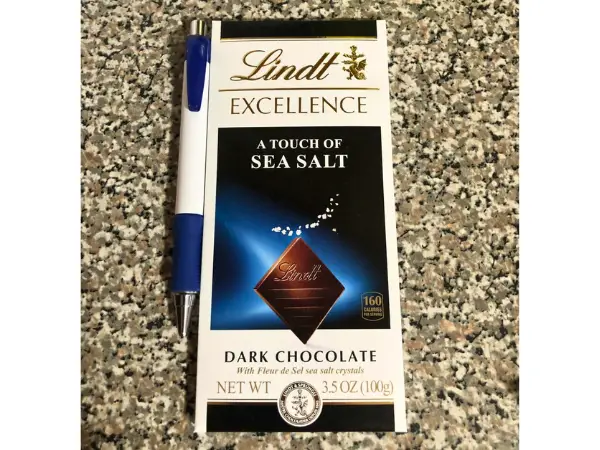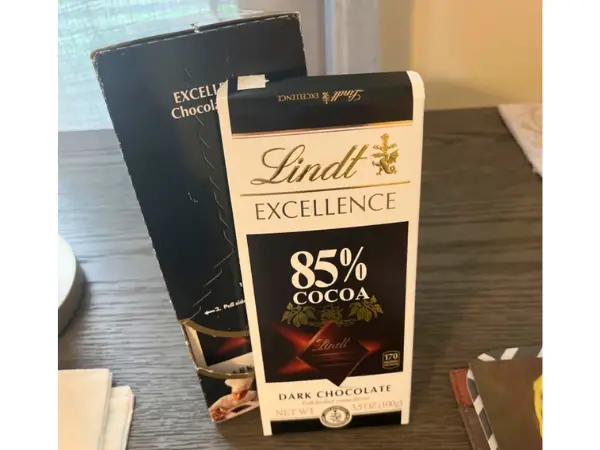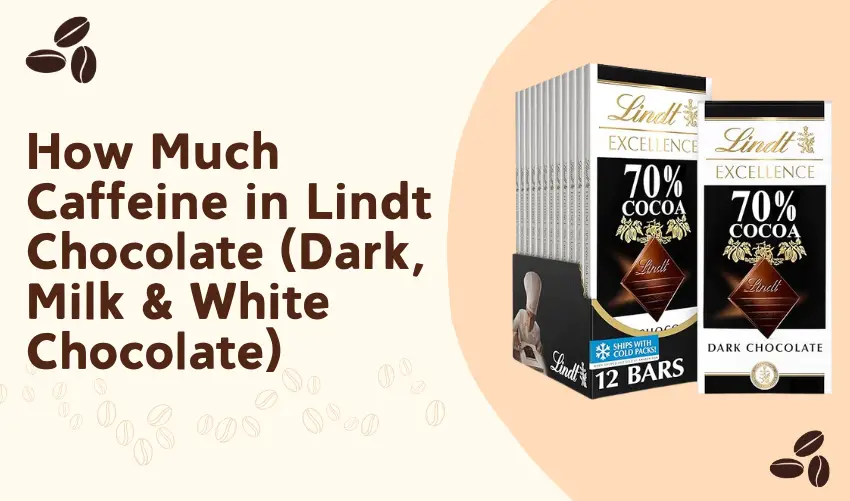Chocolate lovers often wonder just how much caffeine hides in their favorite treat. While Lindt chocolate is known for its smooth, rich flavor, its caffeine content varies depending on the type.
From bold dark bars to creamy milk and sweet white chocolate, this quick guide breaks down how much caffeine you’ll find in each.
What Is Lindt Chocolate?
Lindt & Sprüngli is a renowned Swiss chocolatier, with a rich history dating back to 1845. This brand is famous worldwide for its premium quality chocolate bars, truffles (like Lindor), and various confectionery products.
Key aspects of Lindt Chocolate include:
- Swiss Heritage: A legacy of quality and craftsmanship.
- Global Recognition: Lindt is a trusted name in chocolate.
- Art of Chocolate Making: From bean selection to the final product.
Dark chocolate generally has the highest caffeine levels, while milk chocolate has less. White chocolate contains little to no caffeine, as it does not include cocoa solids.
Lindt’s Commitment To Quality
Lindt’s commitment to quality is evident in every chocolate they produce. The company uses only the finest cocoa beans, ensuring a rich flavor in every bite.
Some highlights of Lindt’s quality commitment include:
- Bean-to-Bar Process: Lindt oversees every step of chocolate production.
- Signature Smoothness: The unique “conching” process creates a melt-in-your-mouth texture.
- Diverse Product Range: Includes Excellence dark chocolate, classic milk chocolate, and creamy white chocolate.
The company’s dedication to quality ensures that consumers enjoy a consistently delightful chocolate experience. This is why Lindt chocolate is loved by many around the globe.

Lindt Dark Chocolate: Caffeine By Cocoa Percentage
Among these, dark chocolate stands out for its richer cocoa content. This cocoa percentage greatly affects caffeine levels. Understanding how much caffeine is in Lindt dark chocolate can help you enjoy it better.
The Higher The Cocoa, The More Caffeine
There is a direct correlation between cocoa percentage and caffeine levels in Lindt dark chocolate. As the percentage of cocoa increases, so does its caffeine concentration. Dark chocolate has the highest caffeine levels among all chocolate types. This is due to its high cocoa solid content.
Here are some reasons why higher cocoa means more caffeine:
- Concentrated Source: Dark chocolate is a concentrated source of cocoa.
- Rich Flavor: The richer the flavor, the more cocoa is present.
- Health Benefits: Higher cocoa levels also bring more antioxidants.
Choosing a higher cocoa percentage can enhance your chocolate experience. It not only increases the caffeine content but also enriches the taste.
Typical Caffeine Estimates (Per 30g Serving)
Caffeine content in chocolate is typically measured per standard serving. A standard serving is often 30g, which is about 1 ounce of chocolate. Here are the typical caffeine estimates for Lindt dark chocolate:
- Lindt Excellence 70% Cocoa: Approx. 20 mg of caffeine.
- Lindt Excellence 85% Cocoa: Approx. 25-35 mg of caffeine.
- Lindt Excellence 90% Cocoa: Roughly 30-40 mg of caffeine.
- Lindt Excellence 95% Cocoa: Estimated around 35-45 mg of caffeine.
- Lindt Excellence 99% Cocoa: Can reach 40-50+ mg of caffeine, as it’s nearly pure cocoa.
These estimates help you decide how much caffeine you consume with your chocolate. Dark chocolate can be a delightful treat that also provides a caffeine boost.

Lindt Milk & White Chocolate Caffeine Content
This section focuses on the caffeine levels in Lindt milk and white chocolate. Understanding these levels can help you choose the right chocolate for your taste and caffeine preference.
Milk Chocolate: Lower Caffeine Levels
Lindt milk chocolate contains reduced cocoa solids compared to dark chocolate. It is diluted by milk and sugar, which lowers the caffeine content. This makes it a mild stimulant.
Here are some key points about Lindt milk chocolate:
- Typical Estimate: A 30g serving of Lindt milk chocolate contains around 6 mg of caffeine.
- Reduced Cocoa Solids: Less cocoa solids mean lower caffeine levels.
- Mild Stimulant: Offers a gentle boost without overwhelming effects.
For those who enjoy chocolate but want to limit their caffeine intake, Lindt milk chocolate is a great choice. It provides flavor without excessive stimulation. This makes it suitable for casual enjoyment.
White Chocolate: Virtually Caffeine-free
Lindt white chocolate is quite different from both dark and milk chocolate. It is made from cocoa butter, sugar, and milk solids. Importantly, it contains no cocoa solids.Typically, it contains less than 2 mg per 30g serving.
White chocolate is ideal for those highly sensitive to caffeine or avoiding it entirely. Here are some facts about Lindt white chocolate:
- No Cocoa Solids: White chocolate lacks cocoa solids, leading to minimal caffeine.
- Negligible Amount: Contains very little to no caffeine, making it a safe option.
- Ideal for Sensitivity: Perfect for those who want to indulge without caffeine.
In summary, Lindt white chocolate offers a sweet treat with almost no caffeine. It allows you to enjoy chocolate without worrying about caffeine intake.
Caffeine Vs. Theobromine: The Chocolate Difference
The difference between caffeine and theobromine plays a key role in how these chocolates affect the body. While caffeine is widely known for its stimulating effects, theobromine, another compound found in chocolate, also contributes to the experience.
Theobromine: Chocolate’s Other Stimulant
Theobromine is a mild stimulant belonging to the same family as caffeine, called methylxanthines. Though both compounds stimulate the central nervous system, they differ in their effects. Theobromine is found in higher concentrations in chocolate.
For example, dark chocolate generally contains much higher levels of theobromine than caffeine. Here is a breakdown:
| Chocolate Type | Caffeine (mg/oz) | Theobromine (mg/oz) |
|---|---|---|
| Dark (70%+ cocoa) | 20-30 | 200-500 |
| Milk | 5-10 | 50-100 |
| White | 0 | 0 |
The higher concentration of theobromine in dark chocolate leads to a gentler effect. It provides a smoother, longer-lasting energy boost, with fewer “jitters” compared to caffeine.
Combined Effects On The Body
The combination of caffeine and theobromine offers unique benefits. These two compounds work together to create a synergistic action. They contribute to chocolate’s mood-enhancing and stimulating properties.
Here are some effects of this combination:
- Sustained Energy: The blend can lead to a more sustained feeling of alertness and well-being.
- Relaxing Properties: Theobromine acts as a vasodilator. This can contribute to a feeling of calm focus.
- Enhanced Mood: Both compounds can improve mood and reduce stress.
This unique mix makes chocolate a popular choice for a quick energy boost. Many people enjoy dark chocolate not just for its taste, but also for its ability to enhance their mood and focus.
